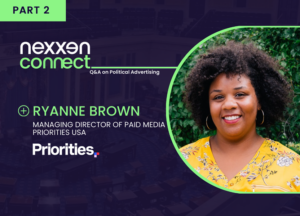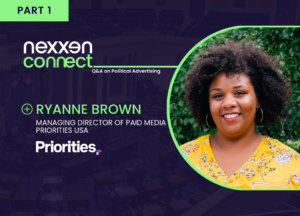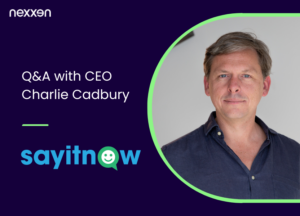

Nexxen Connect: Q&A on Political Advertising with Amanda Ach
In this Q&A, we sat with Amanda Ach, Digital Director from Senate Majority PAC. Amanda Ach oversees all of the organization’s digital advertising programs across Senate battleground states. She also led SMP’s digital efforts in the 2022 cycle, helping Democrats successfully defend and expand their Senate majority.
Prior to joining SMP, Amanda served as the DCCC’s Mountain West Digital Director, overseeing millions of dollars in digital ads spent across a dozen targeted House races, and in 2018, she led the digital program for Senator Martin Heinrich’s successful re-election campaign. She got her start working with startups and non-profit organizations back home in San Francisco.

Amanda Ach
Digital Director, Senate Majority PAC
Per Nielsen, digital video consumption surpassed traditional linear TV consumption in American households this year. Is this the pivot year for digital vs. TV in the political advertising space?
We’ve been on this trajectory for years now, and political advertisers on both sides have consistently been behind the curve. And you can see why. Until this year, linear TV was still the best way to reach the most people. It made sense for linear to be the centerpiece of any paid media plan, even as slightly larger chunks were broken off for digital.
But that’s not the case anymore. Progress takes time, but I’m excited to see our space starting to move away from this idea of digital as a % of a TV budget and towards a more holistic media approach.
Apart from the TV/digital split, what is the biggest change in digital planning best practices that you’d recommend going into 2024?
I’m not sure it counts as a change exactly, but digital plans are getting increasingly complicated and we should just embrace that. A few years ago, we talked about digital as something that was getting absorbed up into TV as “media”. That’s not what’s happening. Digital has just grown and grown – in viewership, in complexity, in capabilities. Our teams and our plans need to reflect that. Digital persuasion advertising takes skill and expertise. It takes many hours and constant optimizations. I think going into 2024, we can’t cut corners. We have to keep being better and smarter than our opponents, because it’s too important not to.
What is the role of traditional digital metrics (e.g. reach, viewability) in grading campaign performance? Should planners be looking towards any newer ways to understand the value of an impression?
We should absolutely be looking at traditional metrics like reach, frequency, video completions, and clicks to make sure we are getting the impressions we paid for. But as we know, these traditional metrics have limitations. As they say, engagement does not equal persuasion.
The persuasiveness of an impression is so hard to measure, and we’re doing ourselves a disservice if we don’t look towards newer ways to solve that problem. Brand lift studies have been a helpful tool in assessing relative persuasiveness within a platform, even if it’s harder to compare across platforms. Pre-flight creative testing is also helpful, letting us know that we’re making the most of each impression with effective creative.
A lot of the conversations I’m having lately have centered around valuing these impressions not by whether the ad ran or how strong the creative is, but by the viewing experience. Is this a big screen TV in a sound-on environment? Is that inherently a more persuasive experience than an Instagram ad? Are all TV screen impressions the same? We need to keep doing work to answer these questions and I know there are smarter minds out there who are.
Last week Google confirmed the Chrome cookie will be deprecated by the end of 2024. How does this change your approach to audience identity in the coming cycle?
Look, I have also been promising to cut out cookies for years and I’ve never done it.
In all seriousness, it does sound like Google is taking these steps. And if I’m being totally honest, I think the death of the cookie will have far less impact than the hype surrounding it.
Digital isn’t most effective when it’s being used to target one person with one message. It’s most effective when we’re finding that intersection between message, audience, and platform. And as digital media overtakes traditional media, it just makes sense for us to paint with a wider brush. That said – I am still never giving up cookies in my personal life.
How do you evaluate the best strategy to implement beyond the voter file – be it ZIP targeting, demographics, or even emerging strategies like contextual?
The reality is that increasingly these decisions are made for us by the platforms as they restrict targeting options. But where we do have flexibility, there are so many factors to consider. How narrowcast or broadcast is this message? Is it more important to get in front of as many people from this group as possible, or to make sure people who aren’t in this group don’t see this ad? And it depends on where you are too – different targeting mixes work best for each state. For example, zip targeting is more effective in some areas and less in others, based on how populations are distributed. I could go on but the tl;dr is that there isn’t one golden ratio of targeting mixes, and making those decisions is a constantly evolving process as platforms, messages, geographies, and dynamics of the race change.
What is your election night celebration tradition?
I mean it sort of depends on how the night goes, but it always involves tweeting. And hopefully champagne. In that order (learned that lesson the hard way).
Where can I reach Amanda with my digital impressions? AKA what are you enjoying on TV lately?
In peak cringe millennial fashion, I am currently doing a Friends rewatch on Max. But you can reach me with your impressions literally everywhere, including linear TV.
Read Next
Connect With Us
Learn how you can effectively and meaningfully leverage today’s video and CTV opportunities with our end-to-end platform, data and insights.


